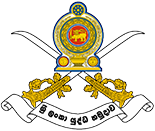A SPECIAL seminar on ‘International Law on Landmines & Explosive Remnants’ organized by the South Asia Small Arms Network, Sri Lanka (SASANET) working in close cooperation with Ministry of Foreign Affairs (MFA) and in partnership with United Nations Children’s Fund (UNICEF), European Commission (EC), Geneva International Center for Humanitarian De-mining (GICHD) and International Campaign to Ban Landmines got underway this morning (27) at the Ceylon Continental Hotel.
Mr. Bernard Savage Ambassador, Head of Delegation European Commission, Mr. Philippe Duamelle, Representative, United Nations Children’s Educational Fund, Commander of the Army Lieutenant General Jagath Jayasuriya, Chief of Staff Major General Mendaka Samarasinghe, several Ministry Secretaries, senior service personnel, officers of the Police and Civil Defence Forces, Diplomats, representatives of UN and other International agencies attended the seminar.
Commander of the Army Lieutenant General Jagath Jayasuriya delivered the keynote address at the inauguration, in which Lieutenant General Jayasuriya urged the International Community to assist Army’s de-mining work speed up by way of supply of more de-mining equipment and training more and more Army personnel for such work.
“During the humanitarian de-mining operations, the Sri Lanka Army had cleared over forty million square metres and approximately ten thousand mines and Unexploded Explosive Ordnance UXOs (in Wanni) have been recovered up to date”, the Commander said in his keynote address to the forum.
Ms. Desiree Jongsma, representative United nations Children’s Education Fund, Mr. Bernard Savage, Ambassador and Head of Delegation, European Commission and Dr. Stuart Maslen, Consultant, Geneva International Centre for Humanitarian De-mining contributed to the inauguration and the sessions.
Here follows the full text of Army Commander’s speech;
“I consider it an honour and privilege to have been invited to deliver the Keynote address today, at this seminar on ‘International Law and Landmines and Explosive Remnants of War’ sponsored by the UNICEF, European Union and the International Campaign to Ban Landmines.
Where Sri Lanka is concerned, I feel this has been organized at the most opportune moment, as we have after thirty years of conflict been able to successfully eradicate terrorism from our country and have at long last achieved long awaited peace. Today, we have entered an optimistic, post-conflict phase, poised to realize the vision of H.E. the President Mahinda Rajapaksa, which is also the dream of each and every citizen of Sri Lanka. We have to think, and act as one people, one nation in order to achieve lasting peace and stability in our country.
In reaching towards our goal, I wish to thank the organizers of this seminar for the timely initiative taken by them to familiarize with the key stakeholders in the Government, regarding the Anti-personnel Mine Convention, and other related instruments such as the CCW Convention Protocol II on Mines and the Convention on Cluster Munitions, enhanced awareness and knowledge of these instruments, which I am sure would contribute positively towards the stabilization process.
The common theme linking all these above instruments is the humanitarian consideration arising from indiscriminate use where victims are concerned. As an example, it is well known that the anti-personnel mines are considered “victim activated weapons”. This means that the use of the weapon is triggered by the victim and not by the aggressor. This has far reaching implications of a humanitarian nature. In the current post-conflict phase in Sri Lanka, it is timely that we focus our attention on the international legal instruments that limit or ban certain weapons based on humanitarian grounds.
Where the Cluster Munitions are concerned, I wish to categorically state that such inhumane weapons have never, and will never be used by the Sri Lankan Armed Forces.
During the last stages of the conflict, interested parties have alleged such use in Sri Lanka, with a view to bringing the Government and the Security Forces into disrepute, which allegations are totally unfounded and baseless.
With regard to the Anti-Personnel Mine Ban Convention, also known as the Ottawa Convention, although Sri Lanka is not a party to the Ottawa Convention in view of the past situation of conflict in the country, Sri Lanka has consistently maintained that Sri Lanka fully subscribes to the humanitarian objectives of the Treaty. Since 1996, Sri Lanka has voted in favour of all Resolutions at the UNGA, which called for a ban on use, stockpiling, production and transfer of Anti Personnel Land Mines and on their destruction. This was a public expression of our support for the humanitarian goal of the Treaty to eliminate the suffering to civilians caused by Anti Personnel Land Mines.
Furthermore, on 13th June 2005, Sri Lanka submitted a Voluntary Report under Article 7 of the Ottawa Convention, compiled by the Sri Lanka Army in consultation with the Ministry of Foreign Affairs as a demonstration of our transparency and commitment towards the underlying objectives of the Treaty.
Sri Lanka became a party to Protocol II Conventional Weapons Convention dealing with mines on 29 September 2004, whereby Sri Lanka undertook to fully adhere to the provisions of the Convention, which requires that the “Parties to a conflict must also distinguish between civilians and combatants, and civilians must not be targeted for attack” and that “the use of weapons that are of a nature to cause superfluous injury or unnecessary suffering” is prohibited.
I also wish to draw attention to the fact that the use of mines by the Sri Lankan military is strictly limited and restricted to defensive purposes only, and not as an offensive weapon; and such defensive mines are laid to demarcate and defend military installations and are marked accordingly; and relevant records systematically maintained, and also that Mines are never used to target civilian populations.
Ladies and Gentleman, these facts clearly demonstrate the commitment of the Armed Forces and the Government of Sri Lanka in voluntarily complying with humanitarian principles and of having acted within the frame-work of the Amended Protocol II of the CCW Convention on Landmines.
Further, the Government has undertaken a Mine Action Plan Programme for de-mining areas that have been cleared of LTTE activities signifying the commitment in working towards a mine free country, subject to Security considerations.
During the three decade old conflict, we in the Sri Lanka Army have witnessed the extent of indiscriminate use of mines by the LTTE amidst civilian populated areas demonstrating the total disregard that this terrorist group had for international humanitarian norms and for civilian lives.
With the end of conflict in Sri Lanka, the large quantities of mines laid by the LTTE in the former LTTE dominated areas have been recovered and are continuing to be recovered by the Sri Lanka Army during the past five months. We have also discovered factories of the LTTE, in which mines had been manufactured, and stored in large quantities. This alone is proof of the inhumane tactics ruthlessly and indiscriminately adopted by the LTTE which endangered the helpless civilians living in areas dominated by this terrorist group. Our experience shows that these deadly mines on almost all occasions leave their victims either dead or maimed and crippled for life. Whilst turning out locally manufactured crude mines and illegally procuring and smuggling sophisticated mines into the island, indiscriminately causing destruction to economic targets and killing and maiming innocent civilians in various parts of the country, the LTTE launched its false propaganda campaign in the international arena blaming the Government and the Security Forces for resorting to unlawful means and methods of warfare.
It is well-known that the indiscriminate use of mines in civilian populated areas by the LTTE considerably delayed the Army offensive in liberating the civilians living in such areas from the clutches of the LTTE. The Army exercised extreme caution to ensure that whilst confronting and neutralizing the LTTE, there should not be any civilian casualties, thereby giving effect to the Government policy of zero civilian casualties.
Let us now for a moment focus our minds to the pertinent question as to how the LTTE acquired these mines and ammunition and smuggled them into this island nation of ours; and our responsibility to ensure and prohibit such malpractices in the future. We need to ensure international measures to prevent the illegal flow of arms and inhumane weapons to non-State actors and terrorist groups, whilst safeguarding the right of sovereign States to self-defence against these forces. In my opinion this would not only require surveillance and security measures being adopted locally by the state key stakeholders but would also need international cross border cooperation and co-ordination. As an island nation, we are particularly concerned about the maritime aspects and the illegal transportation by sea-channels.
We realize that the destructive effect of landmines unfortunately extend even beyond the duration of conflict – one of the most important challenges we face in the post-conflict context of resettling IDPs is the clearing of mines indiscriminately, laid by the LTTE. For the resettlement process, Land mines pose a serious threat. During the conflict in Sri Lanka, it was evident that the LTTE, had laid millions of mines in the areas under their control, disregarding the danger that could be suffered by the innocent civilians.
As per the initial survey carried out, by the Information Management System on Mine Action it was estimated that 1.5 million landmines and unexploded explosive ordnance (UXO) are scattered in the Northern part of the country and over 500 sq km of land area is contaminated with land mines, improvised explosive devices (IED) and UXO in 5 districts of the northern part of the country, namely Jaffna, Mannar, Kilinochchi, Mulaittivu and Vavuniya.
Let me give a brief outline of the de-mining history in Sri Lanka and the role played by the Sri Lanka Army in this process. The Sri Lanka Army initiated De-mining Operations with limited resources, knowledge, and equipment in the Jaffna Peninsula in mid 2002, in order to facilitate the resettlement of IDP’s and assist the reconstruction process. In August 2003 the US state Dept provided assistance through the RONCO consulting co-operation in training and equipping the Sri Lanka Army in Humanitarian de-mining. The SLA Humanitarian De-mining Contingent was upgraded as a professional entity with all three components of Humanitarian De-mining i.e. Manual, Mechanical and MDD. (Mine Detection Dogs) with the assistance of the RONCO.
The RONCO consulting cooperation completed its mission of training 664 Army personnel in different aspects of de-mining in May 2007 and handed over the de-mining operations to the Sri Lanka Army.
The Sri Lanka Army has been engaged in the humanitarian task of de-mining and has been responsible for clearing over 75% of the area de-mined so far. The coordinated effort is assisted by a number of donors, NGOs and UN agencies and we have been able to reduce the monthly casualty rate to 0.33%.
During the humanitarian de-mining operation it was found that greater proportion of the mines are anti personnel type and they can be found virtually anywhere from unmarked minefields to agricultural lands, houses and home gardens, resulting in the displacement of the local population. As per the UN reports, mines have been laid by the LTTE on an ad hoc basis without corresponding records indicating lay-outs.
Let me now draw your attention to the organizations, engaged in Humanitarian De-mining. In this context, to overcome this critical situation, the Government of Sri Lanka has launched an accelerated Humanitarian De-mining (HDM) program with the assistance of the international community, Sri Lanka Army and the INGOs. As a first step General Mine Action Assessment was carried out and all contaminated areas have been identified. As per the assessment over 500 sq km have been identified as a danger area. Out of a total extent of the land contaminated, over 65 percent of the area was inhabited by the civilians and about 25 percent of the area is agricultural lands. The balance area is shrub and thick jungles. Based on the assessments, mapping has been completed and resettlement priorities have been worked out. Tasks have been allocated to various agencies and time lines have been indicated. In order to monitor the process national steering committee for mine action and district mine action offices were established.
Sri Lanka Army humanitarian De-Mining contingent, which is the only such organization operational in Sri Lanka possessing the capability of executing operations through internationally accepted three different methods; Manual, Mechanical and MDD, continues to spearhead the National Mine Action Programme. Therefore, the Government of Sri Lanka has enhanced the capacity by providing all equipment and mechanical assets (Flail Machine) and the total capacity will be upgraded to a fully equipped humanitarian de-mining unit with one thousand de-miners by the end of the year 2009. Further the Government of Sri Lanka had already provided twelve humanitarian de-mining machines to the Sri Lanka Army, which enhanced the capacity tremendously. During the humanitarian de-mining operations the Sri Lanka Army had cleared over forty million square meters and approximately ten thousand mines and UXOs (in Wanni) have been recovered up to date.
The National Steering Committee for Landmines (NSCMA) is the apex body for decision making regarding mine clearance and works in close coordination with the UN, a number of stakeholders, including international and national organizations and the UN agencies including the UNDP in particular. The Presidential Task Force for Resettlement, Development and Security in the Northern Province, headed by Hon Basil Rajapaksa, Senior Advisor to HE the President, is actively engaged in coordinating, monitoring and expediting the Humanitarian de-mining activities. Further, the Government is exploring all possible avenues to obtain the assistances from international donor community, to help us in this mammoth humanitarian operation.
Your Excellencies, I understand that we require and would appreciate assistance from the International community in relation to training of de-miners, and also assistance with machinery and equipment and also the establishment of the Information Management System for Mine Action, which would help us with expediting the de-mining process and facilitate the resettlement of civilians in their original habitats.
With the assistance of the International community, all INGOs and the Sri Lanka Army humanitarian de-mining unit, the Government of Sri Lanka is confident that it could accomplish this gigantic humanitarian operation, clearing of high and medium priority areas expeditiously.
In conclusion, I wish to state that with the end of the conflict, we have had the opportunity to review Sri Lanka’s position with regard to the Ottawa Convention. At the end of the review, we have agreed that as a further voluntary measure, we will submit an update under Article 7 of the Treaty. We will also fulfill our reporting obligation under the CCW Convention.
I take this opportunity to thank the Sponsors who have taken the initiative, in humanitarian interest to sensitize various stakeholders in Sri Lanka, including the Government regarding the terrible humanitarian effect of landmines. The Sri Lanka Army in its operational role in the last 3 decades have witnessed the terrible human cost of their indiscriminate use by the LTTE resulting in loss of life and limbs causing untold suffering to innocent civilians.
I am sure that each one of us is eagerly looking forward to the day that our Island Nation would be a mine free country, which I am sure is within our grasp, and we do certainly hope such a day would dawn in the near future. I also wish the participants an interesting, informative, and stimulating seminar and invigorating interaction. Thank you”.
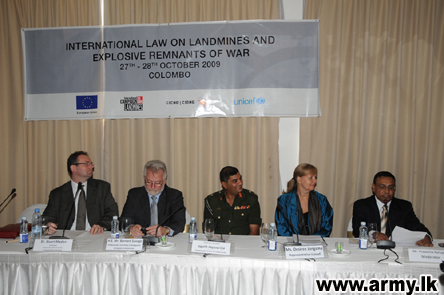 |
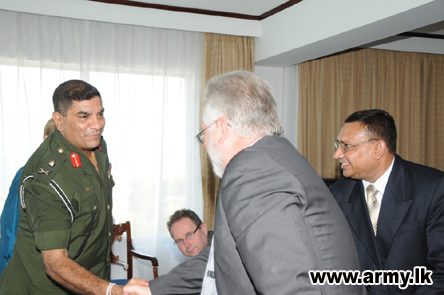 |
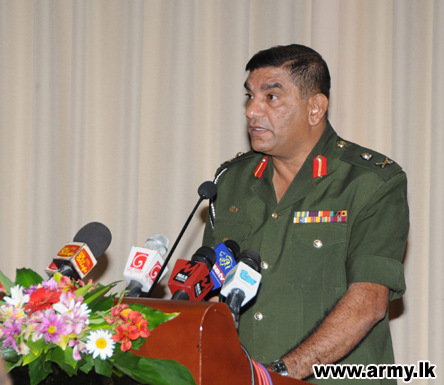 |
 |
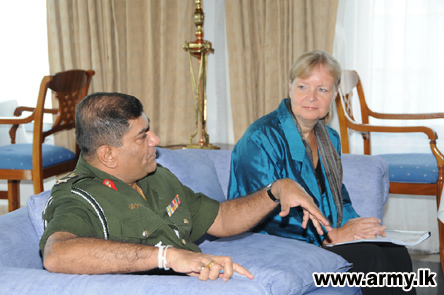 |
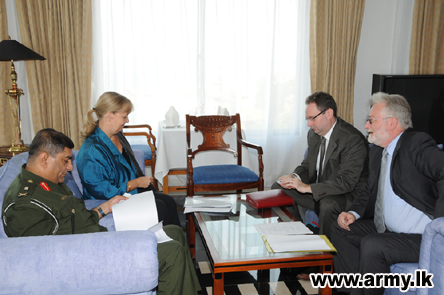 |
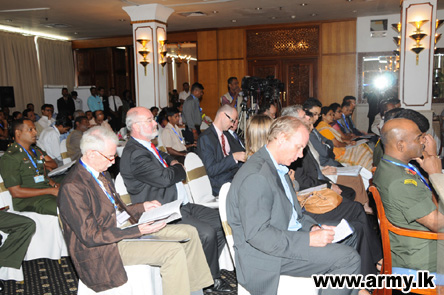 |
